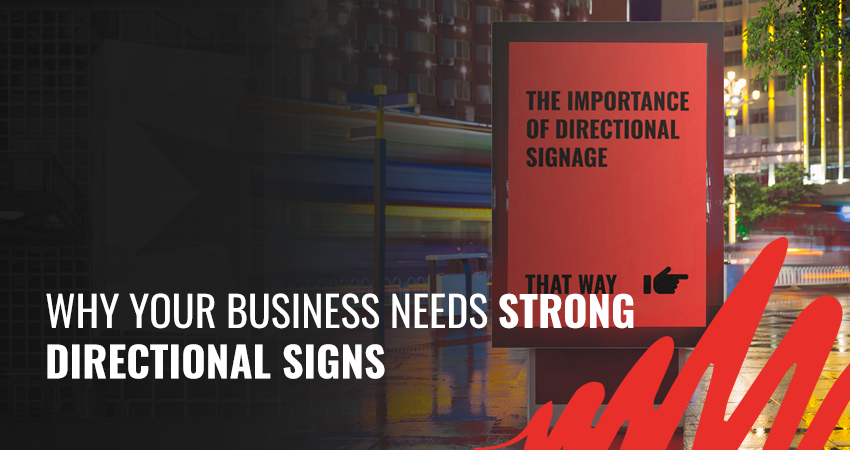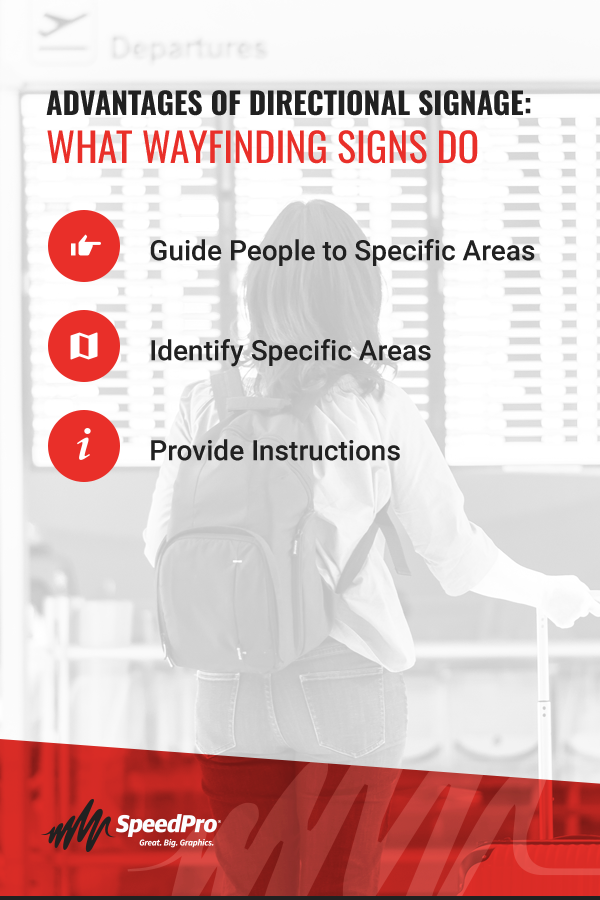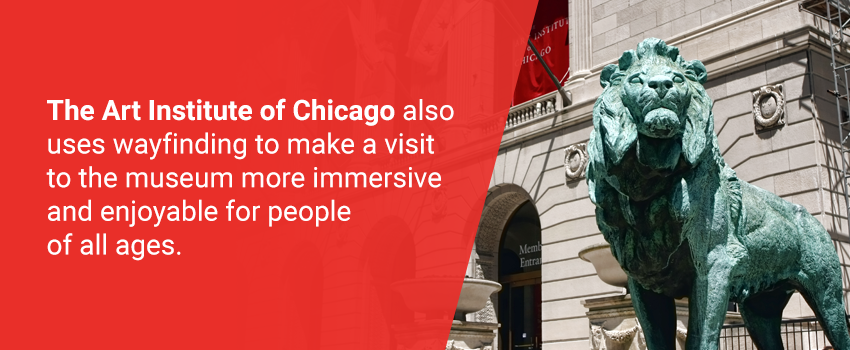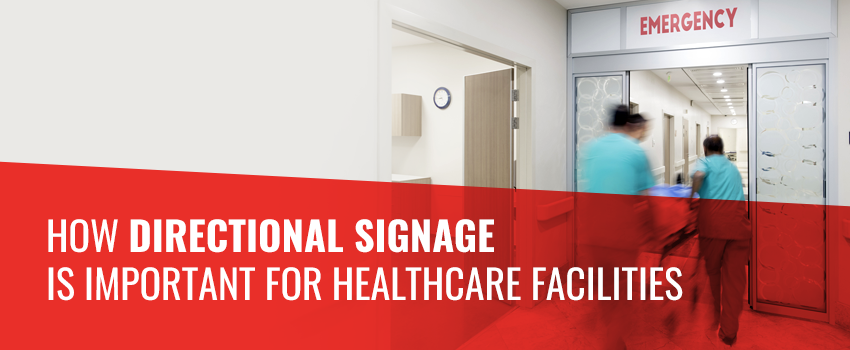
Why Your Business Needs Strong Directional Signs
MAY 20, 2019| SpeedProCategories
SignageSigns are essential for businesses of all types. Although signs that announce a business’ presence and share other types of information with customers — such as details about current promotions or business contact details — can provide economic benefits to companies, they aren’t the only types of signs businesses need to think about. Directional or wayfinding signs are also business must-haves.
“Where am I?” “I’m lost.” “I have no idea how I got here or how to get back.” These aren’t thoughts anyone wants to have while trying to find the restroom in a public building such as a theater, restaurant or shopping mall. But if the way to the restrooms isn’t clearly marked and the facilities themselves aren’t clearly labeled, some variant of “I’m lost” might be what a person thinks. Directional signs that guide people to the bathroom help them avoid feeling lost and confused when they’re out to eat, at the mall or at a theater.
Directional signage goes beyond keeping your customers from getting or feeling lost when they visit your place of business. Wayfinding systems also influence people’s perceptions of your brand and the experience they have with your company. Learn more about the benefits of wayfinding signage systems and how various industries can use directional signs.
Advantages of Directional Signage: What Wayfinding Signs Do
Imagine you’ve just landed at an airport in a country you’ve never visited before. The spoken language of the country is one that you have a minimal grasp on — you know a few phrases, but you can’t hold a conversation in it. You’ve had a long flight, you’re tired and you’re a little nervous about what’s to come. You step off of the plane and into the jet bridge that connects the aircraft to the airport terminal. Once you reach the end of the jet bridge, what’s next?
Luckily, there’s a big arrow pointing in one direction with the word “Arrivals” printed in several languages next to it. You move in the direction of the arrow, joining a stream of fellow passengers. As you walk down the corridor, more signs appear. You recognize the symbols for the restroom, food and drink, luggage carriers and passport control. Directional arrows guide you along the way, so you don’t feel confused or veer off in the wrong direction.
You make it to the passport control area, where you encounter more signs, this time directing people to the appropriate passport control line based on their nationality. The signs also contain information about what documents people need to show once they get up to the passport control counters and what sorts of behaviors aren’t allowed while in line — such as using a cell phone or shouting. There’s a sea of travelers, yet everyone seems able to figure out where to go and what to do once they get there.
Your experience in the airport has just highlighted the three main purposes of directional or wayfinding signs:
- Guide People to Specific Areas: Thanks to the arrows and signage as you walked along the airport corridor, you were able to get to the passport control area without a hitch. Perhaps you stopped in a restroom on your way or bought a coffee or snack.
- Identify Specific Areas: Once you got to the passport control zone, you found your line quickly, thanks to signs directing people and explaining where to go based on the type of passport they hold. Because restrooms and other locations were clearly labeled, you found them quickly.
- Provide Instructions: As you waited, signs let you know what to expect when you finally got a chance to talk to the immigration and customs officer at the end of the line. You had your passport out and the necessary details about your stay in the country or where you were traveling on to next.
After you got through passport control and customs, directional signage continues to help you find your way around. Signs pointing to the taxi stand or subway station help you find a ride to your next destination. If you decide to take the subway, signs directing you to a ticket booth or kiosk help you purchase a travel card or single ride ticket. Maps on the wall of the subway station allow you to figure out what stop to get off at and what subway lines you need to take.
You might be in a new and unfamiliar place, but so far, you’ve felt safe, welcome and confident of where you’re going and what your next steps are — all thanks to wayfinding signs.
Airports are just one example of locations where directional signage can be advantageous. Keep reading to learn how other industries can benefit from wayfinding signs, too.
How Museums and Cultural Institutions Can Benefit From Wayfinding Systems
Museums, performance spaces and other cultural institutions can all benefit from good directional signage. In the case of museums and cultural institutions, top-notch wayfinding signs help people figure out where to go and enhance a visitor’s experience in the building.
A few museums in the U.S. have experimented with wayfinding signs to help visitors learn how to use the available audio tour guides and get more from their visit to the museum — here are three examples.
1. The Detroit Institute of Art
The Detroit Institute of Art has replaced its audio guide with an augmented reality experience. Visitors who are using the augmented reality guide receive help finding the right places to stand and how to maneuver through the museum with the use of virtual blue dots.
2. The Art Institute of Chicago
The Art Institute of Chicago also uses wayfinding to make a visit to the museum more immersive and enjoyable for people of all ages. The art museum created a paper map for children that lists activities to try out as they look at various artifacts on display. For adults, codes printed on the labels of different pieces of art help users of an audio guide find their way to the section that explains more about that specific piece.
3. The Barbican
In some cases, what a cultural institution has done wrong can highlight the need for and benefits of well-designed and crystal clear wayfinding signs. Located it the City of London, the Barbican is a massive complex that consists of multiple apartment towers, an arts center with several theaters and cinemas, art galleries and a conservatory.
The massive complex was part of a grand plan to rebuild the City after it was mostly destroyed during the blitz in World War II. The aim was to get people to move back to the City and offer people a place to see plays, movies and art. For the most part, the Barbican has succeeded, as people flocked to the apartments in its high rise towers and millions of people visit the center each year to see performances by the likes of the Royal Shakespeare Company.
While many are happy once they get into the arts center building and find their seat in the theater, it’s getting to the arts center that has proven to be a challenge. A survey of residents and visitors to the Barbican revealed that many described finding the entrance to the arts center as “difficult” and confusing. The primary concern of the people surveyed was that signage directing them to the complex and center was lacking.
In many cases, the signs around the complex were inadequate. People noted there were signs as they began their walk to the center from points such as the nearby Tube stations, but as they got closer and wanted to know where exactly to go, the signs disappeared. In other instances, multiple signs directing visitors to the same destination pointed in different directions, causing confusion or bewilderment.
Route markers — notably, a yellow line painted along the walkway — that were meant to guide people to the entrance of the arts center weren’t maintained or had been removed in some areas, so people often found themselves following a trail that led nowhere.
A benefit of directional signage is creating feelings of goodwill and happiness in people after they visit a cultural institution and allowing them to maximize their visit to a museum, theater or art center. As the Barbican shows, inadequate or confusing signage does the opposite of what it intends to achieve. People are left feeling confused — as if they don’t belong or aren’t welcome in the space. Even worse, they could end up leaving without doing what they came to do in the first place.
In recent years, the Barbican Center has taken steps to improve its wayfinding signage, such as by installing colorful directional signs in the interior of the building and on the walkways around its exterior, helping people find their way more easily.
How Directional Signage Is Important for Healthcare Facilities
Like cultural institutions and museums, healthcare facilities such as hospitals work with large quantities of people and need to ensure that patients, visitors and medical providers can frictionlessly find their way from one part of the facility to another. Often, healthcare facilities have the added challenge of helping people who might be ill or frightened navigate a complex environment.
In a hospital or other healthcare setting, wayfinding signs’ only function isn’t directing people from one place to the next — they can also help to define the environment and showcase the facility’s brand image.
For example, a pediatric hospital might use signage that appeals to children. It might feature vibrant colors and graphics that are child-friendly. At the same time, the signage should keep in mind that it’s very likely that an adult, such as a child’s parent, will also be looking at the signs and using them to navigate the campus or building. Branding-wise, it’s ideal for a children’s hospital to find a balance between appealing to kids and presenting the necessary information professionally.
One example of a healthcare facility that makes good use of directional signage is Seattle Children’s Hospital. During a redesign of its facilities, the hospital decided to reduce the number of zones it had from seven to four. It also decided to give each zone a theme that was relevant to the hospital’s location in the Pacific Northwest: Mountain, Ocean, River and Forest. When designing each zone, the hospital worked with artists who captured the theme while also incorporating elements into the design that reflected empathy for what the patients and their families were experiencing.
Another way directional signage can benefit healthcare facilities is by pictorially presenting information. Hospitals often see patients from a variety of backgrounds. Although translation services are commonly available to help patients who speak one language communicate with doctors who speak another, those services might not be available immediately to translate signs in the corridors. Using symbols on important signage or offering signs in a selection of languages can help healthcare facilities best serve the needs of a diverse population.
The Benefits of Wayfinding Signage Systems for Any Business
Airports, museums and healthcare facilities are just a small sampling of the businesses and locations that can benefit from an excellent directional signage system. Wayfinding is essential for any company that takes up a physical space.
Here’s a quick recap of the benefits of wayfinding signs:
- Reinforces Brand Identity: Signs that use your company’s signature colors or feature your logo remind people where they are and help them associate your brand with the experience they are about to have.
- Increases Positive Feelings in People: In situations where people might be stressed or worried, having visible signs to point them toward where they need to go means a lot.
- Helps People Find Their Way: In the simplest of terms, wayfinding signs tell people where to go to accomplish their tasks.
- Serves as a Way to Market a Business: Directional signs can also let people know about the existence of a business.
- Frees up Employees’ Time: Signs let your team focus on tasks other than directing people from point A to B. While your team members might be happy to help out lost customers, having to give people directions repeatedly distracts them from their other responsibilities.
Wayfinding and Directional Signage Best Practices
Installing directional signage is just the first step to taking advantage of the benefits of wayfinding systems. There are also a few best practices worth keeping in mind in the design phase and after installation to help your business continue to enjoy the benefits of the signs:
- Create Legible Signs: Choose text that is large enough to be visible from a distance and a font that is easy to read, such as a sans serif font.
- Go for High Contrast: Dark lettering on a light background is easier to decipher than lettering that is similar in color to the backdrop.
- Consider Illumination: Lighting up the sign can make it easier to read in dimly lit areas
- Use Symbols: Sometimes, a picture gets the message across much more quickly than text.
- Keep the Signs up to Date: If locations or names change, your directional signs need to be updated to reflect the most up-to-date information.
- Maintain the Signs: Indoors or outdoors, signs are subject to wear and tear. Replace signs and markers that are no longer legible.
SpeedPro Can Help Your Customers Find Your Business
Whether you want to install a new set of directional signs or your current wayfinding system is in need of an update, SpeedPro can help. Our experts can create a custom wayfinding system that builds on your brand identity and improves your customers’ overall experience. To learn more, locate the SpeedPro studio nearest you today.





















